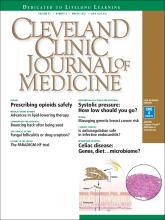Article Figures & Data
Tables
Medication class Intensive therapy (%) Standard therapy (%) Angiotensin-converting enzyme inhibitors or angiotensin II receptor blockers 76.7 55.2 Thiazide-type diuretics 54.9 33.3 Dihydropyridine calcium channel blockers 52.8 31.3 Beta-blockers 41.1 30.8 Aldosterone antagonists 8.7 4.0 Other potassium-sparing diuretics 3.1 2.5 Nondihydropyridine calcium channel blockers 4.7 4.3 Direct vasodilators 7.3 2.4 Information from SPRINT Research Group; Wright JT Jr, Williamson JD, Whelton PK, et al. A randomized trial of intensive versus standard blood-pressure control. N Engl J Med 2015; 373:2103-21 16.
Outcome Percent per year Hazard ratio Intensive therapy Standard therapy Primary outcomea 1.65 2.19 0.75b Secomdary outcomes Myocardial infarction 0.65 0.78 0.83 Other acute coronary syndromes 0.27 0.27 1.00 Stroke 0.41 0.47 0.89 Heart failure 0.41 0.67 0.62b Cardiovascular mortality 0.25 0.43 0.57b Other secondary outcomes All-cause mortality 1.03 1.40 0.73b In patients with chronic kidney disease—decrease in eGFR of ≥ 50% or end-stage renal disease 0.33 0.36 0.89 In patients without chronic kidney disease—decrease in eGFR of ≥ 30% to < 60 mL/min/1.73 m2 1.21 0.35 3.49b Adverse events Percent of patients Hazard ratio Intensive therapy Standard therapy Hypotension 3.4 2.0 1.70b Syncope 3.5 2.4 1.44b Hyponatremia 3.8 2.1 1.76b Hypokalemia 2.4 1.6 1.50b Injurious fall 7.1 7.1 1.00 Orthostatic hypotension without dizziness 16.6 18.3 0.88b Orthostatic hypotension with dizziness 1.3 1.5 0.85 Acute kidney injury 4.4 2.6 1.71b ↵a The composite of myocardial infarction, acute coronary syndrome, stroke, heart failure, or death from cardiovascular causes.
↵b P<.05.
eGFR = estimated glomerular filtration rate, according to the Modification of Diet in Renal Disease study equation.
Information from SPRINT Research Group; Wright JT Jr, Williamson JD, Whelton PK, et al. A randomized trial of intensive versus standard blood-pressure control. N Engl J Med 2015; 373:2103-21 16.
ACCORD BP13 SPRINT1 Trial design Randomized controlled trial, 2 × 2 factorial design—intensive vs standard antihyperglycemic treatment and intensive vs standard antihypertensive treatment Randomized controlled trial, intensive vs standard antihypertensive treatment Number of participants 4,733 9,361 Main inclusion criteria Type 2 diabetes
Systolic pressure 130-180 mm Hg
Age 40 and older (upper age limit 79)Systolic pressure 130-180 mm Hg
Age 50 and olderMain exclusion criteria Serum creatinine > 1.5 mg/dL Stroke, diabetes mellitus Follow-up Mean 4.7 years Median 3.26 years Mean age 62.2 67.9 Female 47.7% 35.6% Black 24.1% 29.9% Baseline cardiovascular disease 33.7% 20.1% Mean estimated glomerular filtration rate 91.6 mL/min/1.73 m2 71.7 mL/min/1.73 m2 Mean achieved systolic blood pressure 119.3 vs 133.5 mm Hg 121.5 vs 134.6 mm Hg Mean achieved diastolic pressure 64.4 vs 70.5 mm Hg 68.7 vs 76.3 mm Hg Mean number of medications 3.4 vs 2.1 2.8 vs 1.8 Diuretic of choice Hydrochlorothiazide Chlorthalidone Primary outcome definition Composite of nonfatal myocardial infarction, nonfatal stroke, and cardiovascular mortality Composite of myocardial infarction, other acute coronary syndromes, stroke, heart failure, and cardiovascular mortality Primary outcome results 1.87 vs 2.09%/year 1.65 vs 2.19%/yeara Individual outcome results Myocardial infarction 1.13 vs 1.28%/year 0.65 vs 0.78%/year Stroke 0.32 vs 0.53%/yeara 0.41 vs 0.47%/year Cardiovascular mortality 0.52 vs 0.49%/year 0.25 vs 0.43%/yeara Heart failure 0.73 vs 0.78%/year 0.41 vs 0.67%/yeara All-cause mortality 1.28 vs 1.19%/year 1.03 vs 1.40%/yeara Adverse events Hypotension 0.7 vs 0.04%a 3.4 vs 2.0%a Syncope 0.5 vs 0.21%a 3.5 vs 2.4%a Hypokalemia 2.1 vs 1.1%a 2.4 vs 1.6%a ↵a P<.05.
Information from ACCORD Study Group; Cushman WC, Evans GW, Byington RP, et al. Effects of intensive blood-pressure control in type 2 diabetes mellitus. N Engl J Med 2010; 362:1575-1585 and SPRINT Research Group; Wright JT Jr, Williamson JD, Whelton PK, et al. A randomized trial of intensive versus standard blood-pressure control. N Engl J Med 2015; 373:2103-21 16.
Outcome Absolute risk reduction Number needed to treat Primary outcome -1.6% 61 Heart failure -0.8% 125 Cardiovascular mortality -0.6% 167 All-cause mortality -1.2% 83 Absolute risk increase Number needed to harm Hypotension +1.0% 100 Syncope +0.6% 167 Electrolyte abnormalities +0.8% 125 Acute kidney injury +1.6% 62 Information from SPRINT Research Group; Wright JT Jr, Williamson JD, Whelton PK, et al. A randomized trial of intensive versus standard blood-pressure control. N Engl J Med 2015; 373:2103-21 16.






